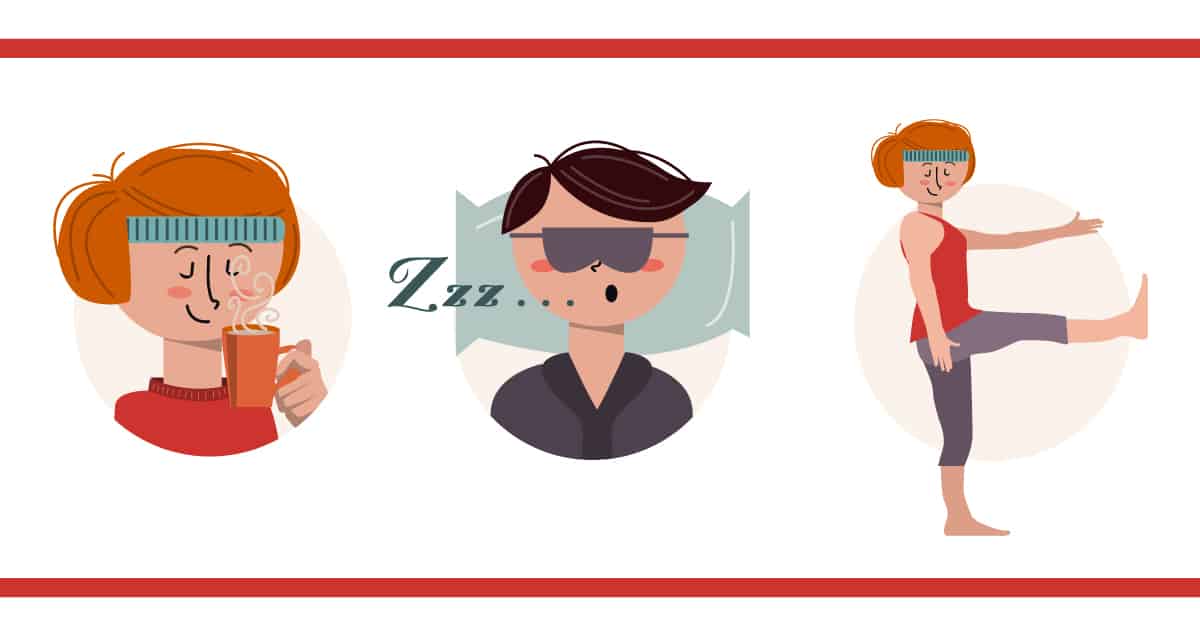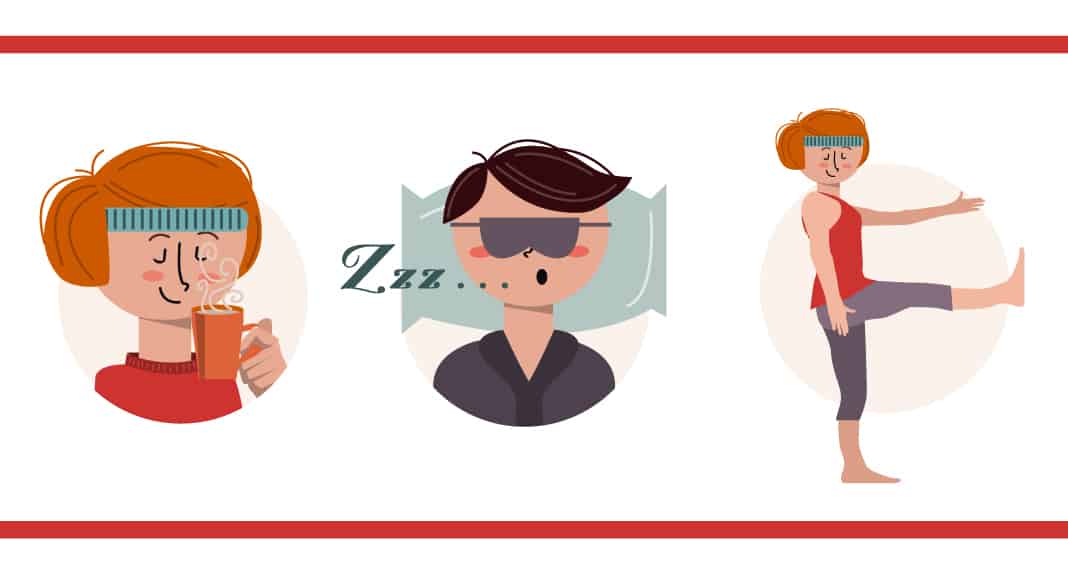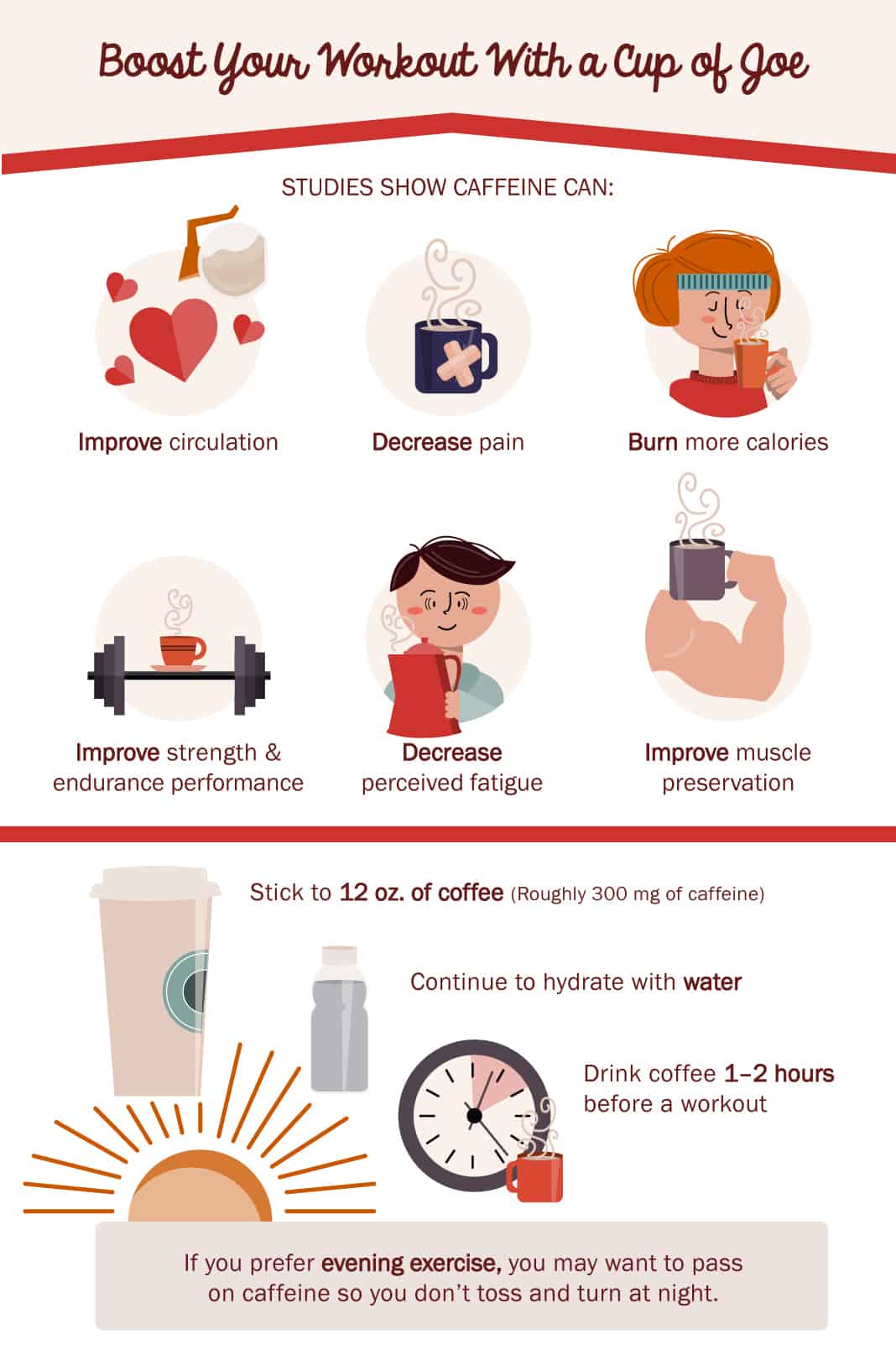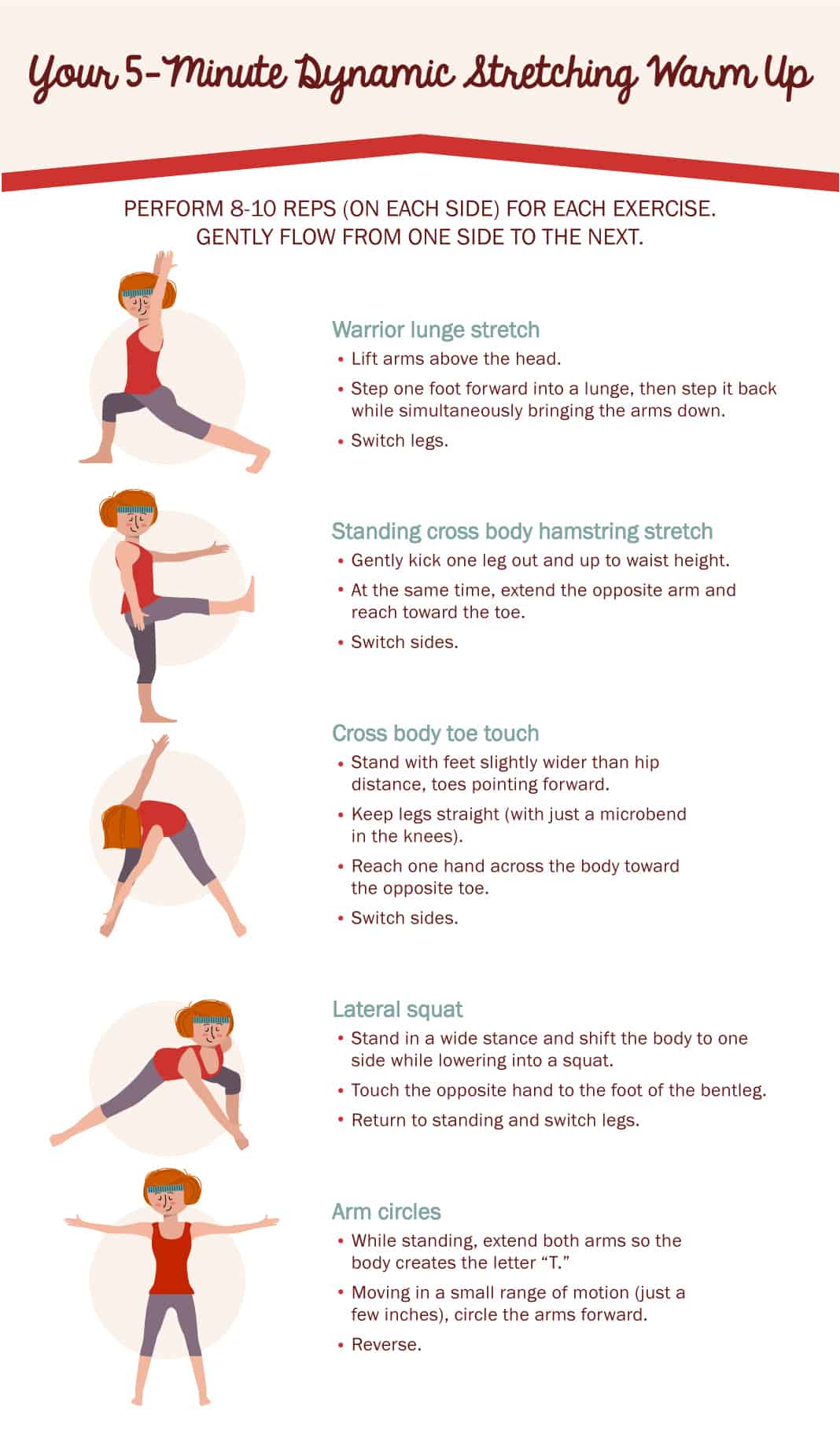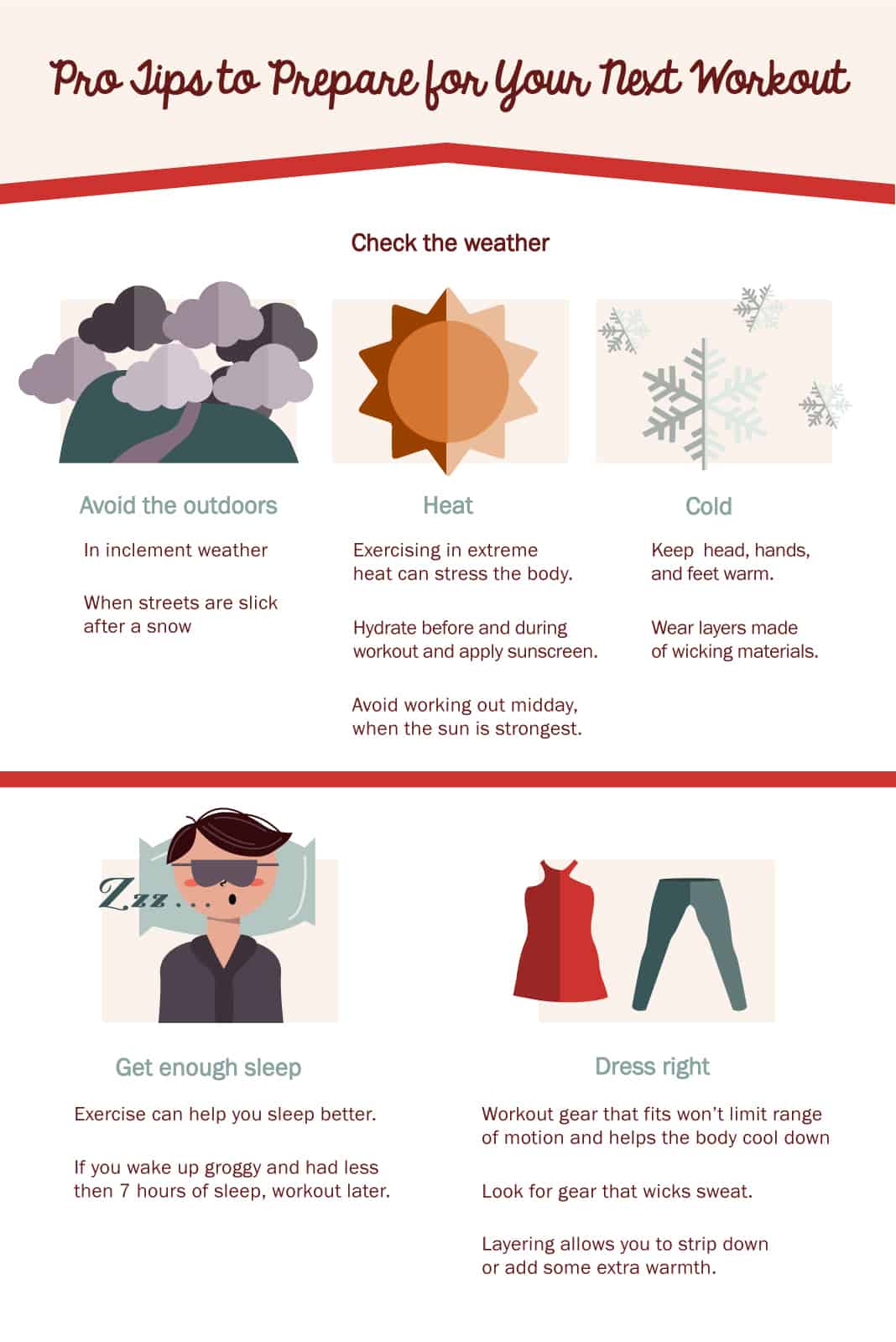Whether at the gym, on the pavement, or in the yoga studio, there are a few general rules that help ensure the best workout possible. Everyone has different pre-workout routines, but nutrition, sleep, stretching, mental attitude, and other factors all affect how you’ll feel during your sweat session.
Here, we break down the best habits to embrace before a workout, along with some unexpected speed bumps that can hinder any good workout.
Ready to Work Out? Your Pre Workout Questions Answered
How much should I eat?
Chowing down before a workout helps us feel energized while exercising. Food-fuel allows the body to gain muscle and burn fat, and also helps the body recover faster (so you can rinse and repeat).
Which foods to eat and when to eat them really depends on a few conditions: hunger, the size of a meal, and your specific fitness goals. If you just need a quick snack, aim to eat 30 to 60 minutes before your workout. Choose something with digestible carbs and a bit of protein, like a banana and peanut butter. If you would like something heartier, have a bowl of oatmeal or scrambled eggs with fresh veggies. For people looking to gain some serious muscle, consider amping up protein intake with foods like egg whites, chicken, nut butter, or a smoothie with protein powder.
Make sure to avoid foods with too much fiber, which can cause unwanted bloating and gas. Stay away from junk food too, which can deplete the body of nutrients we need for workout fuel. Plus, it can be hard to digest. On the flip side, don’t skip out on eating altogether. Though some people who intermittent fast regularly work out during a fasting period, training hard on an empty stomach deprives most people’s muscles of glycogen, which makes them lose steam faster.
How much should I drink?
Hydration is key to any workout, from an intense HIIT session to a few laps in the pool. A good rule of thumb is to drink about two cups of fluids two hours before starting the clock. Water is the best option, but you can try other liquids, such certain sports drinks for electrolytes, which provide extra carbs, sodium, and potassium.
Unless you’re an intense endurance athlete, beware of sugary sports drinks. (Not so fun-fact: A 20 ounce bottle of Gatorade contains nine teaspoons of sugar.) While some sugar is definitely okay before a workout, excess amounts can cause vitamin deficiencies and increase the risk for heart complications. A good alternative is coconut water, which has 15 times more potassium than conventional sports drinks. Just look for one with no sugar added; naturally, it contains about four grams of sugar. Or get creative with your pre-workout routine and make your own sports drink with one of these homemade recipes.
Coffee connoisseur? A cup of joe during the day can actually help your workout. Various studies have found a positive connection between caffeine and improved circulation, reduced pain, and improved muscle preservation. In fact, one study found that athletes who sipped caffeine before they exercised burned 15 percent more calories than those who skipped out.
But don’t always reach for a big cup. Stick to 12 ounces of coffee, which is about 300 milligrams of caffeine for a little boost. Keep it light before a workout by adding skim milk and a dash of cinnamon and drink a glass of water as well to remain hydrated.
If you prefer evening exercise, coffee may be a no go. The caffeine could have you tossing and turning at night. A good rule of thumb is to avoid coffee roughly six hours before you plan on hitting the hay.
How do I get motivated?
Sometimes the hardest part really is that first step. Even when you’re feeling a pang of “I’d rather stay in bed,” there’s a good chance you won’t regret a workout.
There are many creative ways to get pumped about pumping iron. An easy one: Put on your workout clothes. Once you have your sneakers on, it’ll be pretty hard to want to change back into work shoes. Another idea is to keep a workout journal to document how you feel after every workout. Use the journal to remind yourself how awesome it is to get a dose of endorphins. And don’t forget the power of friends. Schedule a workout with a pal to hold yourself accountable and to make the workout more fun.
Power nap: yay or nay?
According to the National Sleep Foundation, a power nap of 20 to 30 minutes can improve alertness and even help boost workout performance. At that time range, a power nap won’t make you feel groggy or hinder your sleep when it’s finally time to hit the hay. If you do take a short nap, allow yourself at least 30 minutes to become fully alert before jumping into your warm up.
What’s the deal with sex before exercise?
Despite myths, sex before a workout will definitely not hinder exercise performance. In fact, some studies link orgasms to reduced pain for women and increased strength (from testosterone) for men. As far as the psychological side, there’s a lack of research on how doing the deed may affect your mental game before a workout. For now, it’s a personal choice.
I feel a bit sick. Should I rest or push through it?
All of this depends on what kind of sick you’re dealing with. If you’re feeling lousy, it’s best to let your body rest so it can recover faster. If you feel crummy above the neck (a sore throat or a runny nose), light exercise could help clear out your sinuses and actually make you feel better. If it’s something from the neck down, like muscle aches and pains, a cough, or congestion, then it’s probably best to skip the gym.
If you feel up to something light, good options for exercise include a brisk walk, a yoga class, or a few laps in the pool. Definitely avoid intense scenarios such as crowded machines at the gym, heavier weights, and endurance runs.
What’s the best way to warm-up?
To make sure your body is prepared to work out, you need to get the blood flowing before going into full-power mode. Warming up is crucial to avoid injuries. It can also lead to a better workout.
Set aside 10 minutes for foam rolling and dynamic stretching before any workout. Foam rolling helps remove knots and scar tissue that builds up in the body. Spend at least five minutes rolling out muscles before dynamic stretches; the latter means you move as you stretch. Dynamic stretches help to activate the muscles you plan to use during your workout and also improve range of motion. Some great examples are bodyweight lunges, squats, hip stretches, and high kicks. Avoid static stretching (holding a stretch for a longer period of time), which can do more hurt than help before a workout.
Don’t Forget These Pro Tips Before Your Next Workout
There are also some unexpected annoyances that may inhibit a good workout. Be aware of the weather, sleep, and workout attire. All three could make or break your time at the gym, or wherever you break a sweat.
Check the weather.
If you’re an outside exerciser, there’s nothing like heading out the door to realize it’s pouring. Avoid the outdoors in heavy rain or thunderstorms or during a snowy or icy winter when the streets are extra slick. Take note of heat, too. Exercising in extreme heat puts extra stress on the body, which could lead to some serious health hazards. Very hot temperatures, generally 90s and above, should draw a red flag.
If it is warm out, hydrate well before and during your workout, and apply sunscreen. Avoid working out midday, when the sun is at its strongest. And if it’s cooler, keep your head, hands, and feet warm, and dress in layers made of wicking materials (avoid cotton). Common sense is the best tool when the weather is iffy.
Get enough sleep.
There are limited studies on physical activity and sleep deprivation. Exercise and sleep are intertwined. In fact exercise can help us sleep better. But if you wake up feeling super groggy with less than seven hours of Zzs under your belt, it’s probably best to sneak in some more shuteye, and save the workout for later.
Dress right.
There’s nothing worse than getting to the gym and realizing you packed pants that are too tight. With the right fit, workout gear won’t limit your range of motion and can help the body cool down. The right clothes are dependent on personal preference, but aim for gear that wicks sweat away from the body. Dress right for the weather and bring layers in case you need to strip down or add some extra warmth.
Conclusion
With just a little bit of planning, a positive attitude, and a delicious pre-workout snack, your next sweat-session will be better than the last.
